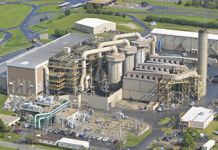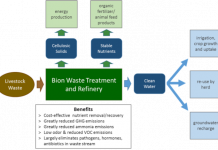Jim Lane
This month in Finland, a team of intrepid researchers herded one thousand European cows one-by-one into a glass “metabolic chamber” to measure their methane emissions, digestion, production characteristics, energy-efficiency, metabolism, and the microbial make-up of their rumens.
The Project is known as RuminOmics, but if it had been titled The Truman Show II: When the Cows Come Home, we wouldn’t have been a bit surprised.
The Cow Emission Crisis. No Kidding Around.
The ultimate aim of the study was to find an optimal, low-emission, high-yield cow, and the team noted in its premise that of all greenhouse gases produced by humans, five percent comes from cattle.
By most conventional measures, that’s more than the global aviation industry. So, when we consider the cost and intensity of the effort to develop sustainable aviation fuels, it adds perspective to this laudable effort to produce a Low Carbon Cow.
Specifically, 16 percent of greenhouse gas impact consists of methane, of which one third originates in cattle production: more than one billion cattle graze the planet, and each of them emit around 500 liters of methane every day.
The Research team
RuminOmics is led by the University of Aberdeen and funded by the EU; in all, ten other European research institutes, investigated the interaction between a ruminant’s genotype, feed, and the microbial make-up of the rumen, examining the role these factors played in the energy-efficiency of dairy cattle and their methane emissions. Cows’ daily feed consumption and milk production is measured and recorded, and the manure and urine produced is collected.
Food creates fuel
The researchers expected that that Finnish and Swedish cows would produce more methane than cows in other countries. “This is attributable to their feed which is dominated by silage, not by the climate.” Yet, results from the study indicate that “many cows with low methane emissions are inefficient due to the fact that they are unable to make use [of the energy] contained in fodder.”
So, it’s not simply a case of selecting cows with low emissions compared to the rest, or varying the diet.
Older and more productive cows emit less
Practice may make perfect, in this case. The researchers found that “relative methane emissions of a cow per production unit, kilo of milk or beef are reduced if the production level or production age are increased.” So, longer lives and better production conditions play a role. Lucky for the cows.
The genetics of low-carbon cows
The study identified areas in the cow’s genotype, the variation of which was linked to the amount of methane produced per kilo of milk produced. So, can a Super Low-Carb cow be identified and can this genotype be bred for.
Consider that noble alternative to the Holstein, the Jersey or the Thai Milking Zebu. For your consideration, the Carbonfree. Researchers are optimistic.
“We will investigate” said their report, “whether these genes affect the variation in the microbial make-up of cows’ rumen or other characteristics of cows such as the size of their rumen, production level of capability to use fodder.”
Making healthier milk
One other impact area of the study? How microbes in the cow’s intestine and rumen on their part play a key role in the functioning of the cow’s entire biological system.
Earlier this week in the Digest we looked at the impact of gut flora (the micro-biome) on human health and the relationship of nutrition and gut health, here.
But there might be a combination of nutritional advantage and progress on greenhouse gas emissions from this work. For example, researchers were targeting microbes to better understand how and why microbes in the cow’s intestine and rumen transform unsaturated fatty acids in fodder into saturated fatty acids in milk. 70 percent of the fats in milk comprises solid fats.
The Low Carbon Cow Standard
If researchers find impactful opportunities, we may find ourselves with the opportunity for a global Low Carbon Cow Standard. Well, it’s silly of course. But not completely.
Consider the climate advantages from, say, reducing cow emissions by half in 2050 compared aa baseline of say, 2005. That would be equivalent to the impact of the entire Sustainable Aviation movement around the world through 2050. And, we might well in addition see a healthier milk in terms of fat profile and nutritional content, or even taste and human digestibility.
So bring on those herds of Carbonfrees.
Jim Lane is editor and publisher of Biofuels Digest where this article was originally published. Biofuels Digest is the most widely read Biofuels daily read by 14,000+ organizations. Subscribe here.








